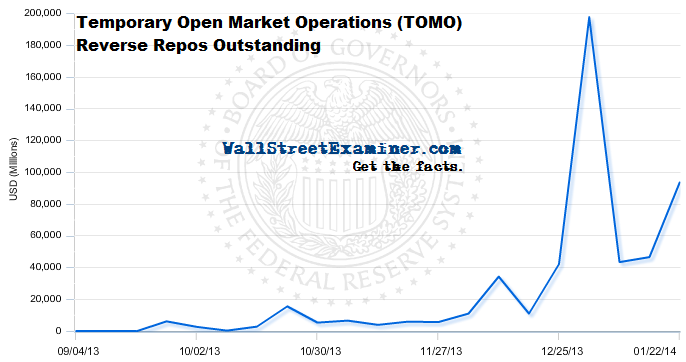by Lee Adler, Wall Street Examiner
The system remains awash in liquidity, but rather than committing it to stocks, those with the cash have continued to either buy Treasuries or park the funds in the Fed’s tri party overnight reverse repo Temporary Open Market Operations. That program is open not just to Primary Dealers, but also to selected banks and money market funds.


Reverse Repos Outstanding – Click to enlarge
The Fed takes in all cash that is offered to it under that program. It posts Treasuries as collateral, and currently offers 3 basis points in interest. The amount outstanding rose to $106 billion on Tuesday, thanks mostly to the Treasury’s $100 billion of paydowns of outstanding T-bills in January. New note supply that settled Friday absorbed some of that, but it was replaced, and then some, as scared money would rather sit at the Fed at 3 basis points than hold it elsewhere.
The history of these reverse repo operations is much too short to draw any firm conclusions, but I suspect that over time they will prove to be an interesting contrary sentiment indicator with rising levels of RRPs outstanding representing increased caution. At 3 basis points, they are clearly not serving the Fed’s stated purpose, which is to put a floor under market interest rates when the Fed deems it necessary.
Instead they have become a safe haven parking spot for institutions that are afraid to let cash sit in regular bank accounts or commercial paper. At the moment the supply of T-bills is insufficient to absorb all of the excess cash in the system. The Fed’s RRPs have become a form of government guaranteed deposit for large financial institutions which don’t qualify for FDIC insurance.
It is an outrage that the Fed pays any interest at all on these funds. It’s money that goes back to the banks and dealers, on funds which the Fed printed and gave them, rather than to the US Treasury as part of the Fed’s regular operating profits. Ultimately the interest the Fed pays the banks comes out of the pockets of US taxpayers. The same is true of bank reserve deposits at the Fed. The RRPs merely extend the universe of counterparties to whom the Fed pays interest.
Meanwhile, the composite liquidity indicator upticked last week thanks to the Fed’s ongoing purchases of Treasuries.
Table of Contents – Professional Edition
- Macroliquidity Component Indicators
- Fed Cash to Primary Dealers
- Foreign central bank purchases
- US commercial bank deposit flows
- Bank Treasury purchases
- Bank Trading Accounts
- Bank reserve deposits
- Commodities
- Treasury Auctions, Federal Revenues and Supply Impact, and Treasury Yields
- Open Market Operations (OMO) and Monetary Policy Actions
- Primary Dealers
- Other Policy Tools and Total Fed Credit
- Other Fed Balance Sheet Items – Liabilities
- Bank Loans Outstanding
- Foreign Central Bank Treasury Holdings
- Fed, ECB, and BoJ Balance Sheets, Vs. US Stocks and Bonds
- The Dollar
- Commercial Paper
- Fannie and Freddie
- Money Supply and Fund Flows
- Bank Holdings of Treasuries
- Bank Capital Trend
Click here to download complete report in pdf format (Professional Edition Subscribers) including 36 pages of charts and clear, cutting edge analysis that you can use to gain an edge in the market. Try the Professional Edition risk free for thirty days. If, within that time, you don’t find the information useful, I will give you a full refund. It’s that simple. 30 day risk free trial for new subscribers. Click here for more information.







